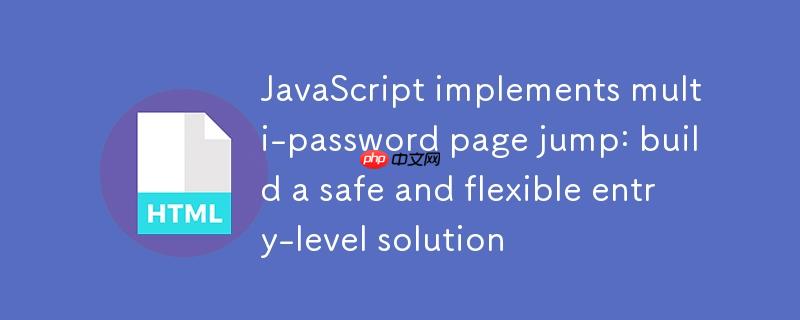
本文旨在指导读者如何使用JavaScript在客户端实现一个简单的多密码页面跳转功能,即用户在一个输入框中输入不同的密码,系统将根据密码内容跳转到预设的不同页面。文章将详细介绍数据结构设计、html与JavaScript代码实现,并着重强调客户端密码处理的固有安全风险,提醒读者此方案仅适用于非敏感、学习或演示场景,不应在生产环境中用于真正的用户认证。
1. 核心概念与安全警告
在构建一个多密码页面跳转功能时,我们的目标是让用户输入一个密码后,根据该密码的值跳转到不同的目标页面。例如,“dogs”密码跳转到 dogs.html,“cats”密码跳转到 cats.html。
然而,在开始实现之前,必须强调一个极其重要的安全警告:将密码及其对应的跳转逻辑直接硬编码或存储在客户端(如JavaScript代码中)是极不安全的行为。 任何能够访问您网站源代码的人(通过浏览器开发者工具)都可以轻易地查看到所有预设的密码及其对应的页面。这使得密码形同虚设,无法提供任何实际的安全保护。
因此,本文提供的解决方案仅适用于:
- 学习目的: 了解JavaScript如何处理用户输入并进行条件跳转。
- 非敏感内容: 仅用于展示或访问无需任何安全保护的公开信息。
- 演示环境: 在不需要真实用户认证的场景下快速搭建原型。
在任何生产环境或涉及敏感信息的应用中,都应采用服务器端认证机制来处理密码。
2. 实现原理:数据结构设计
为了支持多个密码与多个页面的映射关系,我们可以使用一个JavaScript数组,其中每个元素都是一个对象,包含密码 (pass) 和对应的页面名称 (page)。这种结构清晰地定义了密码与目标页面的关联。
立即学习“Java免费学习笔记(深入)”;
例如:
const passwords = [ { pass: "dogs", page: "dogs" }, { pass: "cats", page: "cats" }, { pass: "anotherpassword", page: "secretpage" } ];
当用户输入密码时,我们将在 passwords 数组中查找是否存在匹配的密码。如果找到,则获取其对应的页面名称并进行跳转;否则,提示密码不匹配。
3. HTML 结构:密码输入表单
首先,我们需要一个简单的HTML页面来承载密码输入框和提交按钮。
<!DOCTYPE html> <html> <head> <title>登录页面</title> </head> <body> <form> <label for="pswd">请输入密码:</label> <input type="password" id="pswd"> <input type="button" value="提交" onclick="checkPswd();" /> </form> <!-- JavaScript代码将放在这里 --> </body> </html>
- <label for=”pswd”>:为输入框提供描述。
- <input type=”password” id=”pswd”>:密码输入框,type=”password” 会隐藏用户输入的内容,id=”pswd” 用于JavaScript获取其值。
- <input type=”button” value=”提交” onclick=”checkPswd();” />:一个按钮,当点击时会调用 checkPswd() JavaScript函数。
4. JavaScript 逻辑:处理密码与页面跳转
接下来,我们将编写 checkPswd() 函数来处理用户输入的密码,并根据预设的 passwords 数组进行跳转。
<script type="text/javascript"> // 定义密码与页面的映射关系 const passwords = [ { pass: "dogs", page: "dogs" }, { pass: "cats", page: "cats" }, { pass: "anotherpassword", page: "secretpage" } ]; function checkPswd() { // 获取用户输入的密码 const passInput = document.getElementById("pswd").value; // 在密码列表中查找匹配项 // Array.prototype.find() 方法会返回数组中满足提供的测试函数的第一个元素的值。 // 如果没有找到,则返回 undefined。 const passMatch = passwords.find(o => o.pass === passInput); // 判断是否找到匹配的密码 if (passMatch) { console.log(`正在重定向到: "${passMatch.page}.html"`); // 如果匹配成功,则重定向到对应的页面 window.location = `${passMatch.page}.html`; } else { // 如果没有找到匹配的密码,则提示错误 alert("密码不匹配。"); } } </script>
代码解析:
- const passwords = […]:定义了密码-页面映射数组。
- const passInput = document.getElementById(“pswd”).value;:获取用户在ID为 pswd 的输入框中输入的值。
- const passMatch = passwords.find(o => o.pass === passInput);:这是核心逻辑。find() 方法遍历 passwords 数组,查找 pass 属性与用户输入 passInput 严格相等的对象。如果找到,passMatch 将是该对象;否则,passMatch 为 undefined。
- if (passMatch):检查是否找到了匹配的密码。
- window.location =${passMatch.page}.html;:如果找到匹配项,则将当前窗口的URL设置为目标页面,实现页面跳转。这里使用了模板字符串方便地拼接文件名。
- alert(“密码不匹配。”);:如果未找到匹配项,弹出一个警告框。
5. 完整示例代码
将HTML结构和JavaScript逻辑结合起来,形成一个完整的可运行页面。
login.html (主登录页面):
<!DOCTYPE html> <html> <head> <title>登录页面</title> <meta charset="UTF-8"> <style> body { font-family: Arial, sans-serif; display: flex; justify-content: center; align-items: center; height: 100vh; margin: 0; background-color: #f4f4f4; } form { background: white; padding: 30px; border-radius: 8px; box-shadow: 0 2px 10px rgba(0,0,0,0.1); text-align: center; } label { display: block; margin-bottom: 10px; font-size: 1.1em; color: #333; } input[type="password"] { width: 200px; padding: 10px; margin-bottom: 20px; border: 1px solid #ddd; border-radius: 4px; font-size: 1em; } input[type="button"] { background-color: #007bff; color: white; padding: 10px 20px; border: none; border-radius: 4px; cursor: pointer; font-size: 1em; transition: background-color 0.3s ease; } input[type="button"]:hover { background-color: #0056b3; } </style> </head> <body> <form> <label for="pswd">请输入密码:</label> <input type="password" id="pswd"> <input type="button" value="提交" onclick="checkPswd();" /> </form> <script type="text/javascript"> // 定义密码与页面的映射关系 const passwords = [ { pass: "dogs", page: "dogs" }, { pass: "cats", page: "cats" }, { pass: "anotherpassword", page: "secretpage" } ]; function checkPswd() { const passInput = document.getElementById("pswd").value; const passMatch = passwords.find(o => o.pass === passInput); if (passMatch) { console.log(`正在重定向到: "${passMatch.page}.html"`); window.location = `${passMatch.page}.html`; } else { alert("密码不匹配。"); } } </script> </body> </html>
dogs.html (目标页面示例):
<!DOCTYPE html> <html> <head> <title>狗狗页面</title> <meta charset="UTF-8"> <style> body { font-family: Arial, sans-serif; display: flex; justify-content: center; align-items: center; height: 100vh; margin: 0; background-color: #e6f7ff; color: #333; } h1 { color: #0056b3; } </style> </head> <body> <h1>欢迎!您输入的是DOGS密码</h1> </body> </html>
您还需要创建 cats.html 和 secretpage.html 文件,内容可以类似 dogs.html,但标题和欢迎信息要相应修改。
6. 注意事项与局限性
- 安全性是首要问题: 如前所述,此方法不适用于任何需要实际安全认证的场景。密码明文存在于客户端代码中,极易被窃取。
- 可维护性与扩展性: 对于少量密码,这种数组映射是可行的。但如果密码数量庞大,手动维护会变得困难。
- 用户体验: 密码错误时简单的 alert 提示用户体验不佳,可以考虑更友好的页面内提示。
- URL 可预测性: 由于跳转是基于简单的文件名,用户可以直接在浏览器中输入 dogs.html 来访问页面,绕过密码验证。如果目标页面是私密内容,这显然是不可接受的。
7. 总结
本文详细介绍了如何使用JavaScript在客户端实现一个简单的多密码页面跳转功能。通过定义一个密码-页面映射数组和利用 Array.prototype.find() 方法,我们可以根据用户输入的不同密码将其重定向到不同的HTML页面。
尽管这种方法在技术上可行,但其固有的安全缺陷(密码明文存储在客户端)使其不适用于任何生产环境或涉及敏感信息的应用。它主要作为理解客户端逻辑和JavaScript数组操作的一个入门级示例。对于实际的认证需求,始终推荐使用安全的服务器端认证机制。





评论(已关闭)
评论已关闭